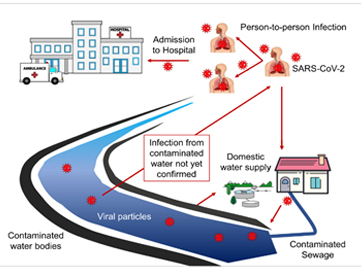COVID-19 Outbreak
Originating from China, the novel corona virus (COVID-19) drastically spread throughout the world in quick span of time and affected almost all countries across the globe. In the last 8 months, COVID-19 has been spread rapidly and infected about 17 million world populations out of which more than 6.5 lacs people died. In Indian scenario, the rate of infection increased abundantly in the last few days which make India the 3rd most affected countries in World. Subjects suffering from infectious and non-infectious diseases of the lungs are found to be more risk from this viral infection due to the lower immune system. Hence, enhancing the immunity (natural body system) may possess the major contribution as a prophylactic measure against multiple pathogenic conditions as well as maintaining optimum health. In recent study in Spain, results showed that only a small population of people have secondary antibodies due to COVID-19 infection which indicates that the immunity developed after COVID-19 infection will not persist for a long time. Hence, there is a high need of development of pharmaceutical sectors including synthetic drug industries, herbal industries and pharmaceutical biotechnology in India.
Literature suggests that COVID-19 outbreak can worsen many business related to tourism and entertainment, however, there are many positive impact of COVID-19 in pharmaceutical industries in India.
Pharmaceutical Industries and Clinical Research
Till date, there are no specific antiviral drugs to cure COVID-19 infection. There are several ongoing clinical trials in many countries to develop a successful drug to combat COVID-19 infection. Indian pharma industry occupies 3rd position in the world and India is a chief provider of low-priced drugs all over the world and is truly recognized as the ‘Pharmacy of the World’. Fifty percent of the US generic drug needs are met by India. The Indian pharma industry aspires to become the world’s largest supplier of drugs by 2030. Zydus, a foremost manufacturer of hydroxychloroquine (HCQ) has already augmented its capacity to produce both the API and the other formulation manifold. Honorable Prime Minister Mr. Narendra Modi cleared HCQ supplies from India to countries like the US, Brazil and Israel. Current global relation among the developed countries suggests that many foreign countries including Europe, USA and Japan might shift their pharmaceutical companies to India. In this context, it may be predicted that there will be an enormous development in pharmaceutical industries in India in future.
Herbal Drug Industries
Ayurveda utilizes the concept of “Dinacharya” and “Ritucharya” to maintain healthy life that utilizes the gifts of nature (herbal medicines) as daily/seasonal regimes to maintain a healthy life. Ayurveda; a plant-based science suggests in simplifying the lifestyle, and also promotes the awareness in uplifting and maintaining owns immune system via the utilization of many plants/herbs which are easily available at the kitchen garden of a majority of the society. Recent studies showed the beneficial effect of many immunomodulator plants like Kalmegh and Ashwagandha and their constituents by inhibiting the interaction of the associated proteins involved in COVID-19 infection. Ministry of AYUSH in collaboration with Council of Scientific & Industrial Research (CSIR) and Indian Council of Medical Research (ICMR) initiated many clinical trials of herbal preparation for the treatment of COVID-19. Recently, Patanjali Ayurved Ltd. developed a formulation “Coronil” which might be helpful of combating COVID-19. In spite of the traditional effect of the Ayurvedic and herbal drugs, the acceptability in foreign markets depends on the scientific data of their safety/toxicity and pharmacology. So, the Ayurvedic companies started to develop the pharmacological/toxicological research in their companies or depend on the pharmaceutical research organizations. Hence, there may be a huge success in the field of Indian traditional system of medicine like Ayurveda as well as pharmaceutical companies after the development of herbal industries.
Pharmaceutical Biotechnology Industries
Pharmaceutical biotechnology companies around the globe are rising to the challenges offered by the COVID-19 from supporting the development of prophylactic vaccines to diagnostic assays. Currently almost 250 COVID-19 vaccine candidates are in Phase 1-3 trials, as well as major candidates in pre-clinical stages of development. Moderna’s mRNA-127, the University of Oxford and Astra Zeneca’s AZD1222, Pfizer and BioNTech’s BNT162 are in pipeline with promising results. Since India is one of the largest vaccine producers in the world, the research institute with industries collaborative work on its way to fast-track vaccine development process. The Drugs Controller General of India (DCGI) has permitted two vaccines, viz., COVAXIN; developed by Bharat Biotech International Limited in collaboration with the Indian Council of Medical Research and another one ZyCoV-D by Zydas Cadila Healthcare Ltd to go in for the first and second phase of human clinical trials. In search of an effective treatment for COVID 19, biotech industries found an old method of fighting infectious disease resurfaced as Convalescent Plasma Therapy. On May 4, 2020, ICMR (Indian Council of Medical Research) has approved 21 institutions in the PLACID trial which was registered with CTRI (Clinical Trial Registry of India).Though ICMR does not recommend this as a treatment option outside of clinical trials, The Ministry of Health and Family Welfare, Government of India has incorporated ‘Convalescent plasma’ as an investigational therapy in patients with moderate disease who are not improving despite use of steroids. Meanwhile, there’s been other experimental fruitful data synergize the development of monoclonal antibody therapies for COVID-19 and provokes the urgent need for actual treatments for COVID-19 by the readjusting of approved immunomodulatory mAbs and other protein candidate through clinical trial projects to get a promising drug molecule
Conclusions
Hence, it is concluded that in spite of the deadly effect of COVID-19, there may a positive impact on pharmaceutical industries in India in future. However, Indian pharmaceutical companies depend on China for the raw materials like active pharmaceutical ingredients which require some amendment of the policy makers of Indian government to develop the active pharmaceutical ingredient sector.














